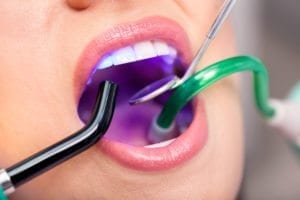The IAOMT warns that fluoride is a dangerous chemical.
Fluoride is not essential for human growth and development. In regard to fluoride dangers, it has been identified as one of 12 industrial chemicals known to cause developmental neurotoxicity in humans. Sources of human exposure to fluoride now include water, food, air, soil, pesticides, fertilizers, dental products used at home and in the dental office (some of which are implanted in the human body), and an array of other consumer items used on a regular basis. Click here to see a detailed chart of which dental related products can contain fluoride.
Potential Health Effects Expose Fluoride Dangers

In a 2006 report by the National Research Council (NRC) of the National Academy of Sciences, fluoride dangers were evaluated. Concerns were raised about potential associations between fluoride and osteosarcoma (a bone cancer), bone fractures, musculoskeletal effects, reproductive and developmental effects, neurotoxicity and neurobehavioral effects, and effects on other organ systems. Click here to read more about the adverse health effects of fluoride.
Since the NRC report was released in 2006, a number of other relevant research studies have been published about potential health risks and fluoride dangers in dental products. Click here to read some of the warnings about fluoride.
The History of Dental Products: A Constant Increase in Fluoride Dangers
Fluoride was not widely used for any dental purposes prior to the mid-1940’s. In 1945, it was first used for artificial water fluoridation in spite of warnings about fluoride dangers, as well as doubts about its alleged usefulness in controlling dental caries.
Meanwhile, fluoridated toothpastes were introduced and their increase in the market occurred in the late 1960s and early 1970s. By the 1980s, the majority of commercially available toothpastes in industrialized countries contained fluoride. Other fluoridated dental products were likewise promoted for more common commercial use in recent decades.

Read the labels of your toothpaste, mouthwash, and floss to check if they contain fluoride, and consider using fluoride-free dental products to reduce your exposure.
Fluoride Dangers in Dental Products Used at Home
Fluoride from dental products used at home contributes to overall exposure levels. Many consumers utilize fluoride-containing toothpaste, mouthwash, and floss in combination on a daily basis. Accidental swallowing of any of these products, especially by children, can result in a dangerous level of fluoride.
Additionally, fluoride releases from these products occur at rates which vary by person due to the frequency and amount of use, as well as individual response. However, they also vary by the specific brand of the product used. Overall, the average consumer is unaware of how the concentrations listed on the labels translate into meaningful numbers and how much fluoride is dangerous. This issue has even been studied specifically from the perspective of the misleading marketing used for children’s toothpastes.
Fluoride Dangers in Dental Products Used at the Dental Office
 Some of the materials used at the dental office can likewise result in the potential for dangerous fluoride exposure levels. For example, prophy paste, used during teeth cleanings at the dental office, can contain over 20 times more fluoride than toothpaste sold directly to consumers. As another example, fluoride varnish treatments contain high-concentrations of fluoride.
Some of the materials used at the dental office can likewise result in the potential for dangerous fluoride exposure levels. For example, prophy paste, used during teeth cleanings at the dental office, can contain over 20 times more fluoride than toothpaste sold directly to consumers. As another example, fluoride varnish treatments contain high-concentrations of fluoride.
Additional fluoride dangers from exceeding safe exposure levels can come from dental filling materials. Many of the options contain fluoride, including all glass ionomer cements, all resin-modified glass ionomer cements, all giomers, all polyacid-modified composites (compomers), certain types of composites, and certain types of dental mercury amalgams. Fluoride-containing cements are also sometimes used in orthodontic band cements.
Conclusions about Fluoride Dangers in Dental Products
Understanding fluoride exposure levels from all dental sources is crucial because recommended intake levels for fluoride should include these common multiple sources. Unfortunately, the potential danger for dental products to increase overall fluoride levels is often overlooked. In fact, there is a significant gap in scientific research that includes fluoride releases from procedures and products administered at the dental office as part of overall fluoride intake.
Given these fluoride dangers and current levels of exposure, policies should reduce and work toward eliminating avoidable sources of fluoride, including artificial water fluoridation, fluoride-containing dental materials, and other fluoridated products, as means to promote dental and overall
health.
Fluoride Article Authors
Dr. Jack Kall, DMD, FAGD, MIAOMT, is a Fellow of the Academy of General Dentistry and a past President of the Kentucky chapter. He is an Accredited Master of the International Academy of Oral Medicine and Toxicology (IAOMT) and since 1996 has served as the Chairman of its’ Board of Directors. He also serves on the Bioregulatory Medical Institute’s (BRMI) Board of Advisors. He is a member of the Institute for Functional Medicine and American Academy for Oral Systemic Health.




